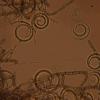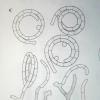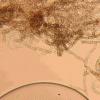
12-11-2021 00:03
Lepista ZacariasHi everybody,A week ago in my fiels trip I noticed

29-12-2025 17:44
Isabelle CharissouBonjour,J'aimerais savoir si d'autres personnes au

29-12-2025 17:12
 Bernard CLESSE
Bernard CLESSE
Bonjour à toutes et tous,Pourriez-vous m'aider à

29-12-2025 17:01
Gernot FriebesHi,I'm looking for help with this hyphomycete with

29-12-2025 08:30
Hello.A tiny ascomycete sprouting under Juniperus

29-12-2025 10:15
Hulda Caroline HolteHello, I found and collected this propoloid ascom

29-12-2025 09:38
Oskari VirtanenHi,could anyone help me identify this, I suspect P
Hyphomycete Coating Fagus Cupule
Peter Thompson,
01-11-2017 13:26
I have found a cupule of Fagus sylvatica coated with a pure white hyphomycete, resembling flakes of snow. It is easily detachable from the host.
Hyphae - pale brown, thin walled, multiply septate, branched, with a diameter of 5 - 6.5 um.
Conidia - Helicoid, multiply septate, 2.5 um broad, spiral measuring 28 - 40 um across. When straightened, the length is approximately 238 um.
I have attached a photo of the fruit bodies and a microphoto of the hyphae and conidia.
I wonder if anyone has any idea as to what it might be?
Thank You,
With Best Wishes,
Peter.
Martin Bemmann,
01-11-2017 13:47

Re : Hyphomycete Coating Fagus Cupule
Hi Peter,
looks like Helicomyces (Tubeufiaceae).
Regards
Martin
looks like Helicomyces (Tubeufiaceae).
Regards
Martin
Peter Thompson,
01-11-2017 16:02
Re : Hyphomycete Coating Fagus Cupule
Hello Martin,
Thanks for your reply.
I did consider Tubeufia species, but they seem to have erect, unbranched conidiophores, rather than the structure of branched hyphae which I saw.
With Best Wishes,
Peter.
Thanks for your reply.
I did consider Tubeufia species, but they seem to have erect, unbranched conidiophores, rather than the structure of branched hyphae which I saw.
With Best Wishes,
Peter.
Martin Bemmann,
01-11-2017 16:33
Peter Thompson,
01-11-2017 17:11
Re : Hyphomycete Coating Fagus Cupule
Hello Martin,
Thank you for attaching the image.
It seems that H. roseus is illustrated as being white rather than pink, as the name might suggest. Martin Ellis did not include it in his two books about hyphomycetes.
I will look again at my sample again in better light tomorrow to see if I can see the conidiophores and hyphae more clearly.
There does not seem to be a sexual state ascomycete associated with this taxon.
With Best Wishes,
Peter.
Thank you for attaching the image.
It seems that H. roseus is illustrated as being white rather than pink, as the name might suggest. Martin Ellis did not include it in his two books about hyphomycetes.
I will look again at my sample again in better light tomorrow to see if I can see the conidiophores and hyphae more clearly.
There does not seem to be a sexual state ascomycete associated with this taxon.
With Best Wishes,
Peter.
Martin Bemmann,
01-11-2017 17:24

Re : Hyphomycete Coating Fagus Cupule
According to Goos 1985 the teleomoph is Tubeufia cylindrothecia, refering to Barr 1980: 153.
Peter Thompson,
02-11-2017 15:22
Re : Hyphomycete Coating Fagus Cupule
Hello Martin,
That is interesting. I found the sexual state of Tubeufia cylindrotheca at another site back in August.
In Index / Species Fungorum, the conidial state and sexual state are listed separately, rather than being linked. I think that I/SF is about 97% accurate, so these fall into the inaccurate 3%, it seems.
I have attached two more photos of the Helicomyces hyphae. Not sure whether they provide extra information, but I notice that they are multiply branched, often at 90 degrees.
With Best Wishes,
Peter.
That is interesting. I found the sexual state of Tubeufia cylindrotheca at another site back in August.
In Index / Species Fungorum, the conidial state and sexual state are listed separately, rather than being linked. I think that I/SF is about 97% accurate, so these fall into the inaccurate 3%, it seems.
I have attached two more photos of the Helicomyces hyphae. Not sure whether they provide extra information, but I notice that they are multiply branched, often at 90 degrees.
With Best Wishes,
Peter.
Martin Bemmann,
02-11-2017 22:09

Re : Hyphomycete Coating Fagus Cupule
Hi Peter,
Goos and Barr are quite old sources. I did a BLAST in Genbank for a Tubeufia cylindrothecia (KY320518.1). The nearest Helicomyces was H. lilliputeus with 92% identity and H. roseus with 91% identity only. On the other hand, when you do the same for a H. roseus (AY856928.1) you will recieve a T. helicomyces with 99% identity but together with lots of other species of T. and H. with the same rate. So anamorph/teleomorph relation is still unclear.
Regards
Martin
Goos and Barr are quite old sources. I did a BLAST in Genbank for a Tubeufia cylindrothecia (KY320518.1). The nearest Helicomyces was H. lilliputeus with 92% identity and H. roseus with 91% identity only. On the other hand, when you do the same for a H. roseus (AY856928.1) you will recieve a T. helicomyces with 99% identity but together with lots of other species of T. and H. with the same rate. So anamorph/teleomorph relation is still unclear.
Regards
Martin






